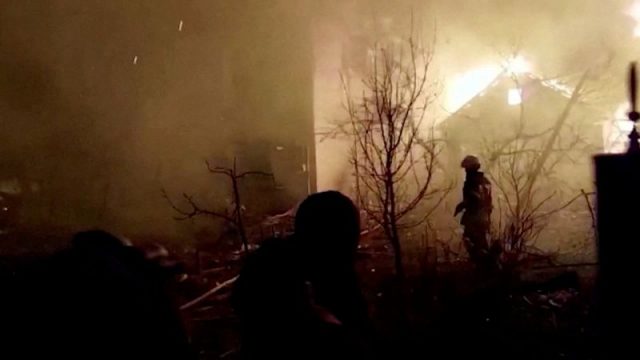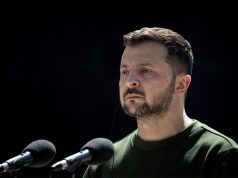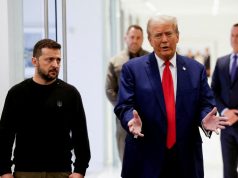
A commentary.
LONDON — As Russian troops faced fierce resistance to their assault on Ukraine, a Russian-language account on the Telegram messaging app identified what open-source analysts said appeared to be a Russian TOS-1A thermobaric multiple launch rocket system on a road between Kyiv and the town of Sumy.
CNN also reported that a similar weapons system had been identified in Belarus, close to the border with Ukraine.
Thermobaric weapons suck in oxygen from the surrounding air to generate a high-temperature explosion, typically producing a blast wave of a significantly longer duration than that of a conventional explosive. They are capable of vaporizing human bodies.
The reports about thermobaric weapons have heightened Western concerns that President Vladimir Putin is steppIng up Russia’s military onslaught and could deploy some of the most powerful weapons in Moscow’s conventional arsenal to target urban areas, with potentially devastating consequences.
Ukraine says it has retained control of its major urban centers, and U.S. and British officials say Russia’s invasion has probably not achieved its initial objectives.
But Russia still has more forces and weapons to throw into the fight even though Putin faces worldwide condemnation and international sanctions over what he calls a “special operation” to destroy Ukraine’s military capabilities and capture what Moscow says it considers dangerous nationalists.
Putin ordered Russia’s strategic nuclear forces to be put on heightened alert on Sunday, a move he said was necessitated by aggressive statements from NATO leaders, and a senior U.S. defence official told Reuters that Russian forces appeared to be switching to a “siege mentality”, increasing the risk of civilian casualties.
A Ukrainian presidential advisor also said Russian forces were now trying to lay siege to Kyiv and the northeastern city Kharkiv, Ukraine’s second-largest.
In previous wars, particularly in the North Caucasus region of Chechnya but also in Syria, Russia has shown little or no qualms about the use of vast firepower, despite the risk of civilian casualties.
But Oksana Markarova, Ukraine’s ambassador to the United States, accused Russia on Monday of using a vacuum bomb in Ukraine. “The devastation that Russia is trying to inflict on Ukraine is large,” she told reporters.
“The devastation that Russia is trying to inflict on Ukraine is large.”
Amnesty International and the watchdog Human Rights Watch have both said that Russian forces appear to have used widely banned cluster munitions.
Russia has denied targeting civilians. The Russian embassy in Washington did not respond to requests for comment, and White House Press Secretary Jen Psaki said did not have confirmation that Russia had used such weapons.
Media war
Ukrainian, international and Russian audiences are getting very different impressions of the war. Global and Ukrainian news channels have largely concentrated on the capital Kyiv, which independent analysts and Western governments say Russia set out to encircle.
U.S. satellite firm Maxar has said a convoy of armoured vehicles, tanks and other equipment stretching around 40 miles (64 km) appears to be closing on the capital.
Ukrainian President Volodymyr Zelenskiy has said the capital remained Russia’s “key target” and must not be taken.
Ukrainian media outlets – combining efforts to stay on the air – are feeding a continuous diet of stories intended to hold up resistance as towns on the outskirts of Kyiv, the eastern city of Kharkiv and elsewhere come under fire. The internet remains on in much of the country, with videos of destroyed or stranded Russian vehicles widely shared. Ukraine has instructed its population to avoid sharing social media imagery of its own forces, largely keeping coverage of their activity from the internet and wider media.
Mainstream Russian media reports have concentrated on what are portrayed as military victories in eastern Ukraine that they credit largely to the forces of the separatist self-proclaimed republics of Luhansk and Donetsk, which were recognised by Russia as independent states last week. Russian media closely controlled by the state invariably echo Putin by referring to a “special operation” by Russia.
The Russian media coverage makes it likely that many people in Russia are unaware of much that is going on in Ukraine.
Talks between Russian and Ukrainian officials on the Belarus border on Monday yielded no immediate breakthrough and Ukrainian media have reported that the government expects forces from Belarus to join the conflict, despite promises by Russia’s ally not to do so.
There have been anti-war protests in Russia, with several thousand people reported detained so far, but polling conducted by the government has been quoted by Russian media as showing overwhelming support for the intervention in Ukraine.
Washington has refused to consider a “no-fly zone” over Ukraine for fear of triggering a wider war with Russia, but many countries have now taken steps against Russia, with some announcing significant weapons shipments this week such as anti-tank and anti-aircraft missiles.
Despite Russian efforts to control the skies, Turkish drones used by Ukraine appear to still be operating and Ukrainian media have reported offers of fighter jets from Bulgaria, Slovakia and Poland. An unconfirmed report by Ukrainian media suggested Warsaw could let Ukrainian pilots fly from Polish air bases.
That could increase Ukrainian hopes of saving its air force after heavy bombing of its air bases but there would be potential risks. If Russia chose to attack Polish bases in response, it could trigger NATO’s Article 5 self-defence clause and potentially suck the Western military alliance into a direct conflict with Russia. — Timothy Heritage
—
Peter Apps is a writer on international affairs, globalisation, conflict and other issues. He is the founder and executive director of the Project for Study of the 21st Century; PS21, a non-national, non-partisan, non-ideological think tank. Paralysed by a war-zone car crash in 2006, he also blogs about his disability and other topics. He was previously a reporter for Reuters and continues to be paid by Thomson Reuters. Since 2016, he has been a member of the British Army Reserve and the UK Labour Party.








